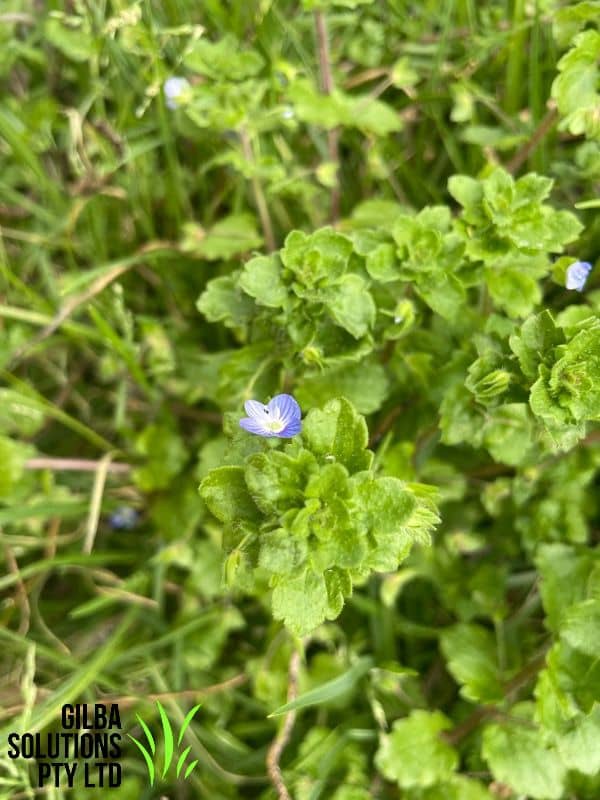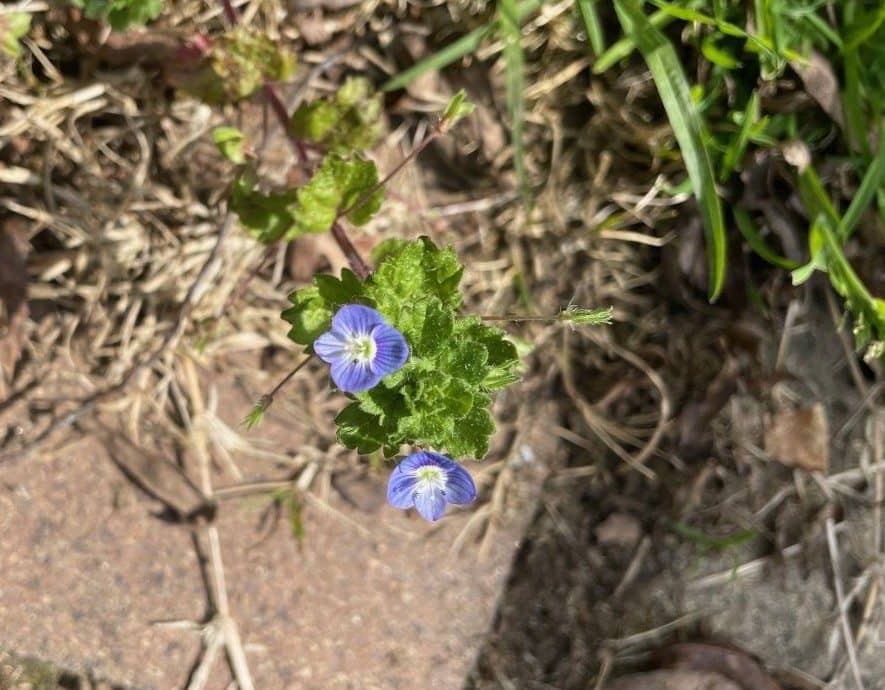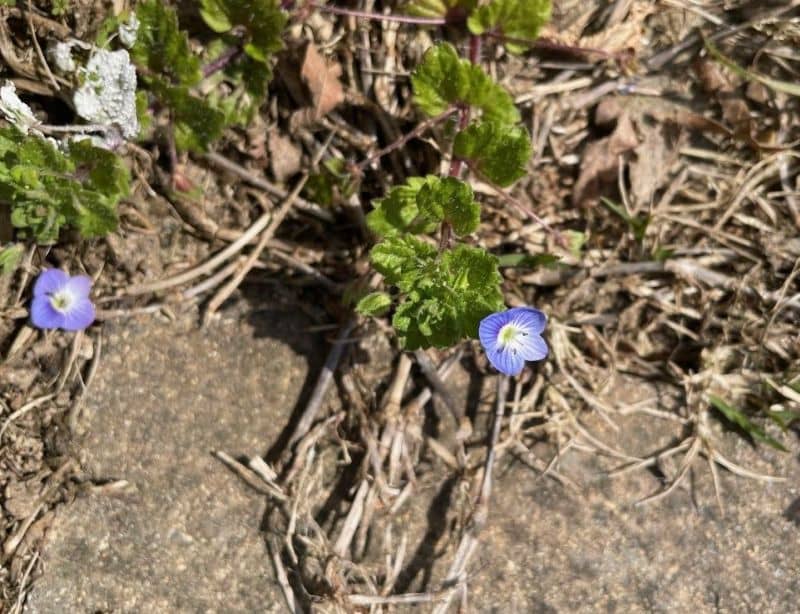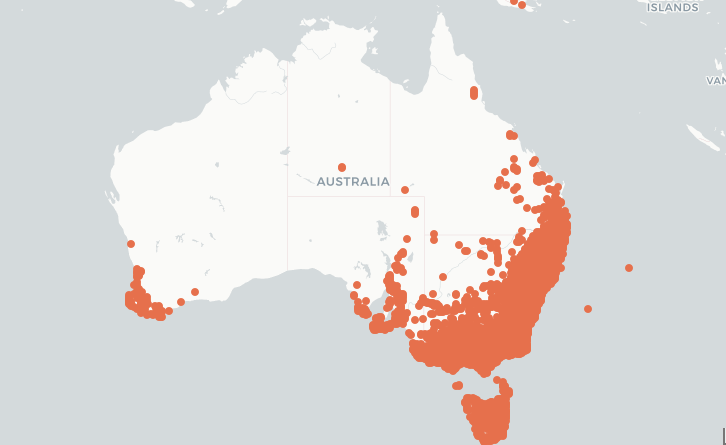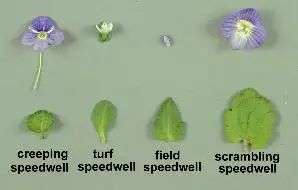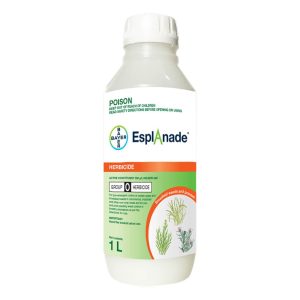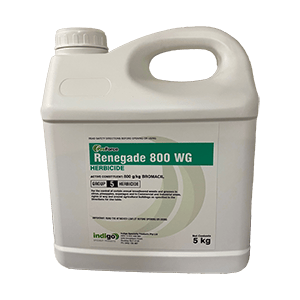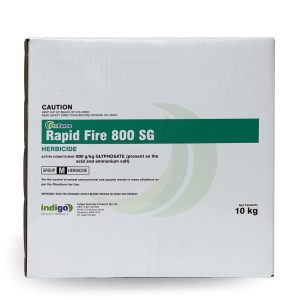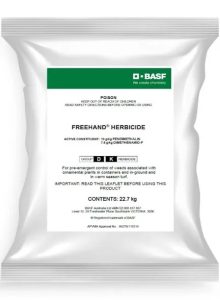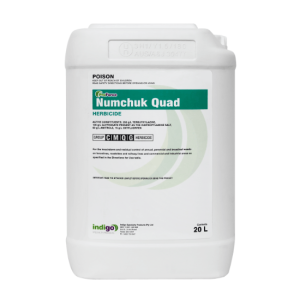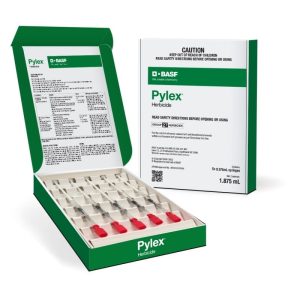Speedwell Weed (Veronica spp).
Speedwell, Creeping Speedwell or Bird’s Eye Speedwell are perennials that prefer moist, well drained soils. Some Speedwell weeds like Veronica persica can have slender rhizomes up to 60 cm long.
You can find these weeds in a range of environments. They tend to die back in dry periods but then reshoot once it rains.
After you read this, you will be able to:
- Identify these weeds.
- Know their habitat.
- Know the best cultural and chemical way to control them.
Speedwell Weed Identification.
You can easily identify the Speedwells. Their leaves have an oval shape, and they have numerous small flowers in a range of colours spread out over their stems.
Category: These are broadleaf (Dicot) weeds.
Photosynthetic Pathway: They are C4 weeds.
Birds-eye or Creeping Speedwell:
-
Growth habit: This is a prostrate, low growing annual (sometimes it is a short-lived perennial) weed.
-
Leaves: It has broadly ovate, coarsely toothed leaves. These have hairs on their upper and lower surfaces. The leaves are relatively large in comparison to other Speedwells.
-
Flowers: The flowers are a bright sky-blue with a white centre. They are ~8 to 12 mm across and on stalks. This weed has the largest flowers of the four.
- How it spreads: It spreads by stolons and seeds. It grows into thick weed mats and then smothers turf.
-
Habitat: It favours disturbed soils, and lawns.
-
Control: Because it is a very small weed it easily escapes when you mow. It is tolerant of most turf herbicides.
Field, Corn or Wall Speedwell (Veronica arvensis).
-
Growth habit: This is a small, upright Winter annual weed, that is usually <15 cm tall. This means that it germinates in the Autumn and flowers in the Spring.
-
Leaves: Field Speedwell has hairy leaves. The lower ones are round/ovate, whilst the upper ones are narrower and clasp the stem.
-
Flowers: Its flowers are tiny (~2–4 mm) and blue to lilac in colour. The flowers are so small that they are often hidden among the upper leaves. These small, blue flowers only open on bright days.
- How it spreads. This weed only spreads by seed.
-
Habitat: It favours dry, sandy soils, and is often found along walls and paths. It is found in Canberra & The Southern Tablelands.
| Creeping Speedwell (Veronica persica) | Field (Veronica arvensis) | |
| Seed longevity: | > 5 years | 1 – 5 years |
| Seeds/flower: | 7 | 15 |
| Seeds/plant: | 50 to 10,000 | 15,000 |
Thyme or Turf Speedwell (Veronica serpyllifolia).
-
Growth habit: This is a low growing perennial weed that forms dense mats.
-
Leaves: It has small, hairless, round to oval, opposite leaves. These look like the leaves of Thyme.
-
Flowers: Its flowers are a pale lilac-blue to white and have dark lines. The flowers are 4 to 6 mm across and not on stalks.
-
How it spreads: It spreads mainly by stolons but it also produces small seeds.
-
Habitat: This weed favours damp lawns, and shady areas.
Slender Speedwell (Veronica filiformis).
-
Growth habit: This a creeping perennial weed with slender stolons that forms dense mats.
-
Leaves: The stems and undersides of the opposite leaves are hairy, roundish, and have scalloped edges. They are smaller than V. persica but larger than V. serpyllifolia.
-
Flowers: The flowers area a pale lilac to blue colour. They are ~6–8 mm across and often have dark stripes.
- How it spreads: It spreads mainly by stolons as its seeds tend to be sterile.
-
Habitat: Lawns and grassy areas.
A Comparison Table of The Veronica species.
Species | Growth Habit | Leaves | Flowers | Reproduction | Habitat | Key ID Features |
Veronica persica (Creeping speedwell) | Prostrate, sprawling annual (sometimes short-lived perennial) | Broad, ovate, coarsely toothed; usually hairy | Bright sky-blue with white centre, 8–12 mm | By seed (abundant, easily spread) | Disturbed soils, lawns, crop fields | Largest flowers, showy blue, hairy leaves |
Veronica serpyllifolia (Thyme-leaved speedwell) | Low-growing, mat-forming perennial | Small, rounded, opposite; mostly smooth (nearly hairless) | Pale lilac-blue to whitish, 4–6 mm | By seed + short stolons (can root at nodes) | Damp lawns, shady ground, woodland edges | Tiny thyme-like leaves, pale flowers, nearly hairless |
Veronica arvensis (Wall speedwell) | Small upright annual (<15 cm tall) | Lower leaves ovate, upper leaves narrow and sessile; slightly hairy | Tiny blue to lilac, 2–4 mm, often hidden | By seed only | Dry soils, sandy ground, walls, paths | Tiny almost hidden flowers, upright habit, slightly hairy |
Veronica filiformis (Slender speedwell) | Creeping perennial with stolons (mat-forming) | Round, scalloped, opposite; smooth (hairless) | Pale lilac to blue, 6–8 mm, with stripes | Mainly stolons (creeping vegetative spread), rarely sets seed | Lawns, pastures, grassy areas (introduced groundcover) | Creeping mats via stolons, lilac flowers, smooth leaves |
For more information, please check out our weed ID chart. Speedwell weed is a good indicator weed of wet soils and shade.
Comments: Most vegetative growth occurs during the cool weather in the late Winter or early Spring.
The image below is courtesy of Massey University.
How to Control Speedwell Weed in your lawn.
Cultural Control of Speedwell Weed.
Dense, healthy lawns will choke out this weed.
- Cut at the right height for your turf grass.
- Irrigate appropriately.
- Fertilise properly. Don’t skip on N as this just favours this weed. You want the turf to outcompete this weed.
Chemical Control of Speedwell Weed.
Management Calendar for Speedwell.
Management Calendar for Speedwell | ||||||||||||
Month | Jan | Feb | Mar | Apr | May | Jun | Jul | Aug | Sep | Oct | Nov | Dec |
Germination | ||||||||||||
Flowering/Seeding | ||||||||||||
Pre Emergent Herbicide | ||||||||||||
Post Emergent | ||||||||||||
Pre-emergent Herbicides.
- BASF Freehand suppresses Veronica sp.
- In NZ Envu Esplanade has a label to control Veronica persica.
Post Emergents for Speedwell Weed.
- Use these in the Spring and the Autumn when the plants are actively growing.
- Don’t mow for two or three days before or after application. Use when there is no rainl forecast for at least 24 hours.
- You can control Corn Speedwell with Carfentrazone, Quinclorac and Tenacity herbicides (not registered in Australia).
- MCPA does not work well vs Speedwells.
- In the USA you can use Xonerate (Amicarbazone) to suppress Speedwell.
- Pylex has a label for post emergent Veronica sp suppression and control in the USA.
- Trifloxysulfuron has a label for this weed in the USA but not in Australia.
- Most 3 way mixes of post emergent herbicides like Stature and Warhead Trio will control this weed.
Table of Post Emergent Herbicides for Speedwell.
Product | Active | Chemical Group | Rate/Ha | Comments |
2,4-D | 2,4-D | 4 | 1.8-3.2 L | Wet foliage. DO NOT mow lawn for 1 week before and at least 1 weed after use. DO NOT use on Buffalo grass (WA only). |
Casper | Prosulfuron + Dicamba | 2 and 4 | 800 g-1 Kg | Use from the Autumn to the Spring. Use high rates in cool months or if there is high weed pressure. Control takes 4 to 6 weeks. Use an NIS at a rate of 0.25 to 0.5% v/v. |
Contra M. | Dicamba + MCPA | 4 | 6.5 L | Apply in 250-400 L of water. DO NOT use on Buffalo grass. After use do not mow for 2 days before or after use or fertilize within two weeks |
Dicamba | Dicamba | 4 | 1.2 L + 3.2 L of 2,4-D Amine 625 g/L | Use a minimum of 1000 L/Ha water. Do not spray on Buffalo or Bent Grass. |
Warhead | MCPA + Clopyralid + Diflufenican | 4 + 12 | 5 L | You may see discolouration on kikuyu, carpet grass and Queensland blue. Avoid overlap. Use an NIS. |
Weed Blast MA. | Bromoxynil + MCPA | 6 + 4 | 3-6 L | Apply in a minimum of 500 L/Ha water. DO NOT mow for 2 days after use. |
Non Selective Control.
- Glufosinate-ammonium provides control for 4 to 6 weeks, but it regrows and recovers due to the limited movement of glufosinate.
- Glyphosate. You can use Glyphosate but if you use Glyphosate, and water quality is an issue then use ProForce Manta Ray.
The following are non-selective but also have a long term residual and stop any re-growth.
- Renegade. Renegade stops germination for up to 12 months, and reduces the need for multiple herbicide applications.
- Numchuk Quad. This gives effective post and pre emergent Speedwell control for up to 12 months.
- Cortex Duo. Cortex Duo gives a rapid knockdown, and residual control for up to 3 months. It is also safe to use around trees.
Table of Non Selective Herbicides for Speedwell.
Product | Active Ingredient | Group | Use Rate/Ha |
Glufosinate 200 | Glufosinate-ammonium | 10 | 1 to 6 L |
Rapid Fire 800 | Glyphosate | 9 | 0.9 to 1.35 Kg |
Numchuk Quad | Terbuthylazine + Glyphosate + Amitrole Oxyfluorfen | 5 + 9 + 34 + 14 | 20 to 25 L |
Cortex Duo | Nonanoic Acid + Oxyfluorfen | 14 | 7 L/1000L |
Renegade | Bromacil | 5 | 3.5 to 6.5 Kg |

